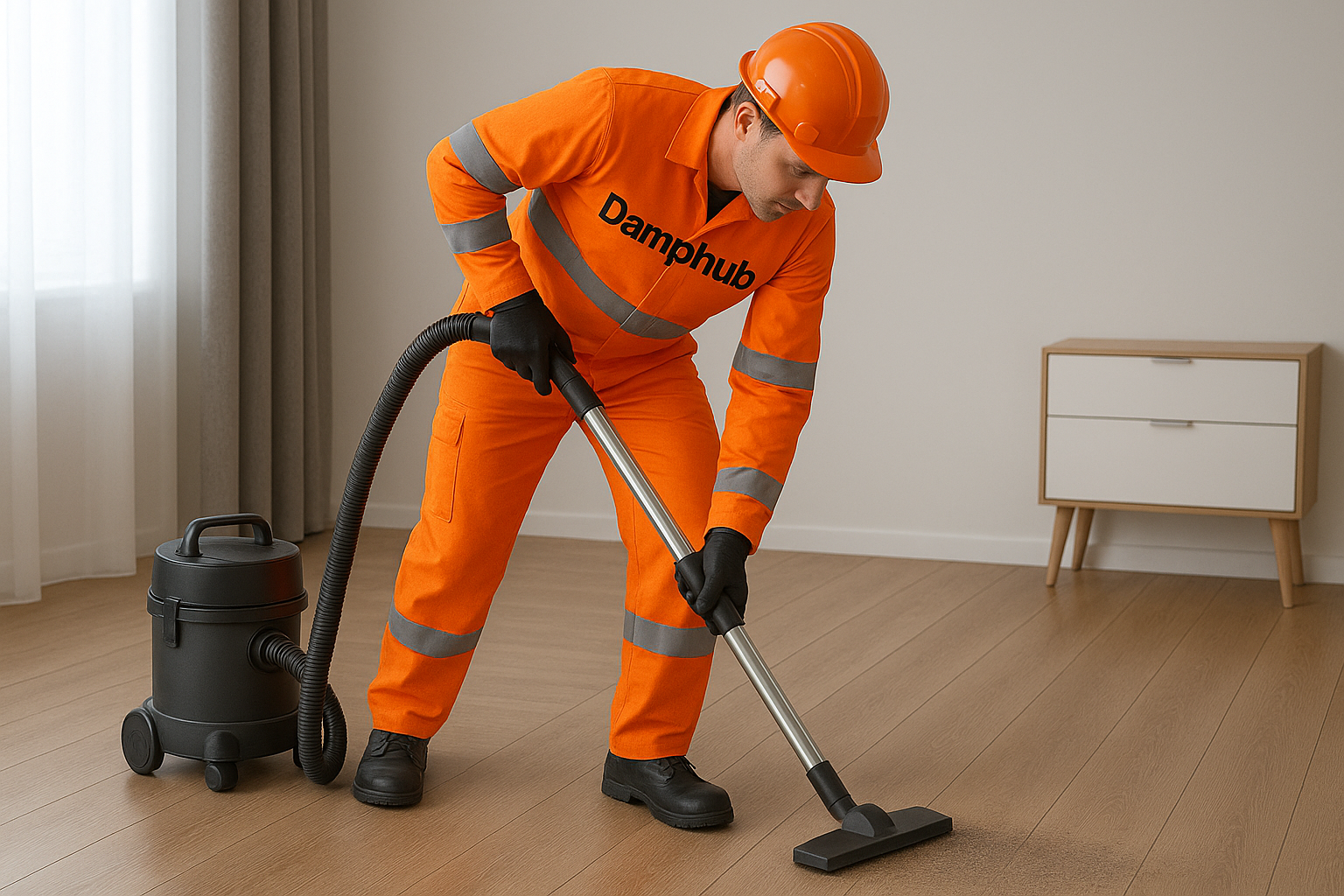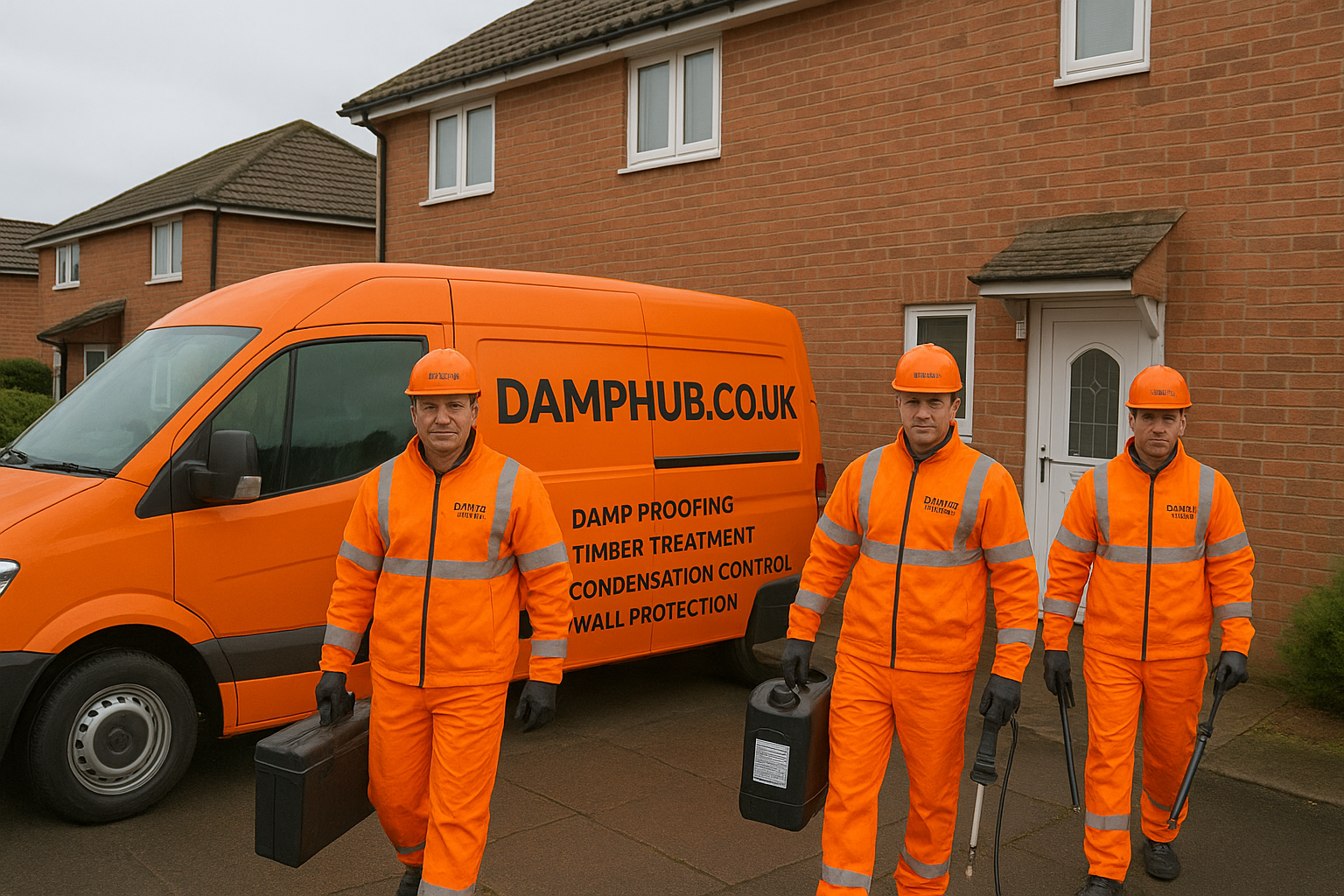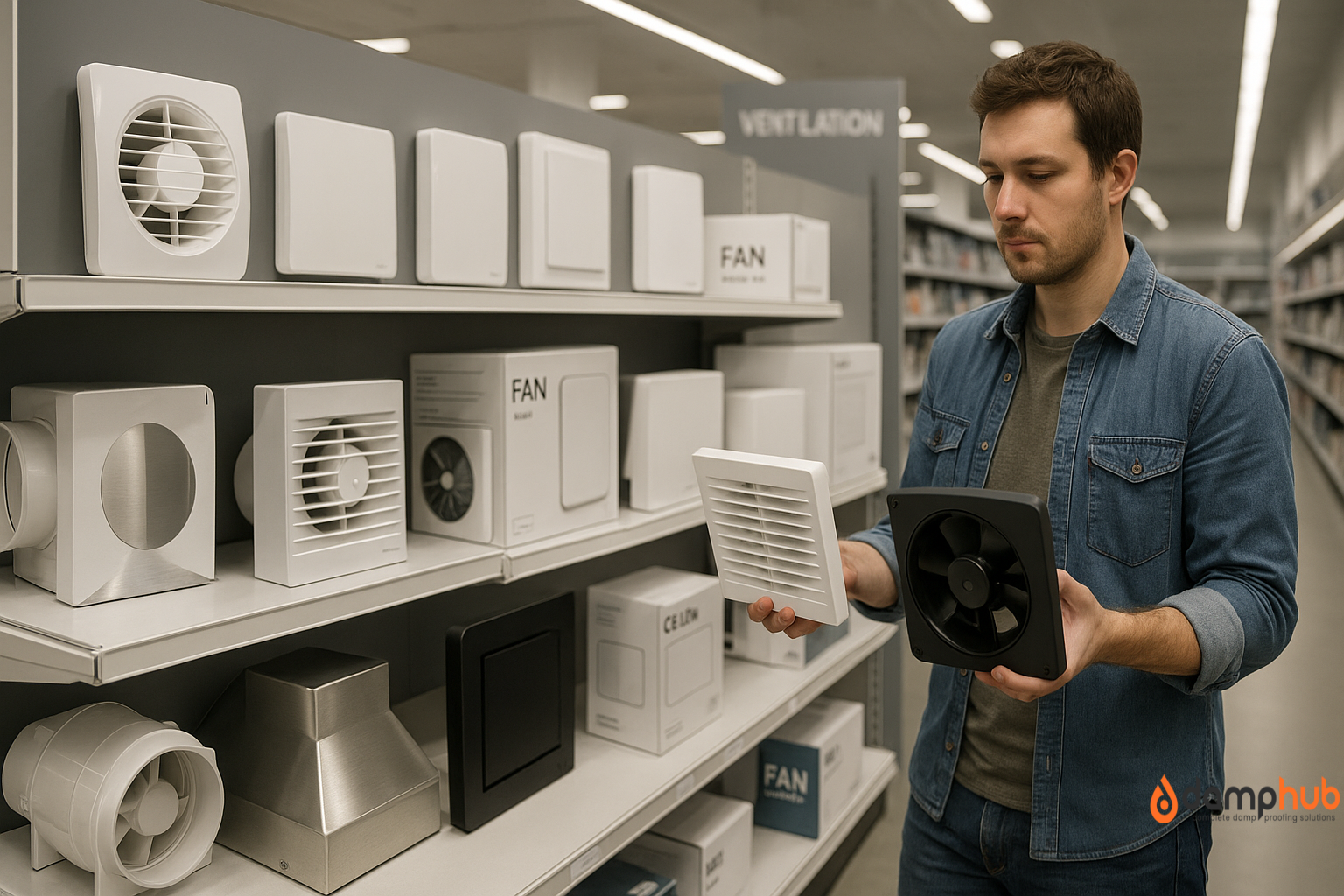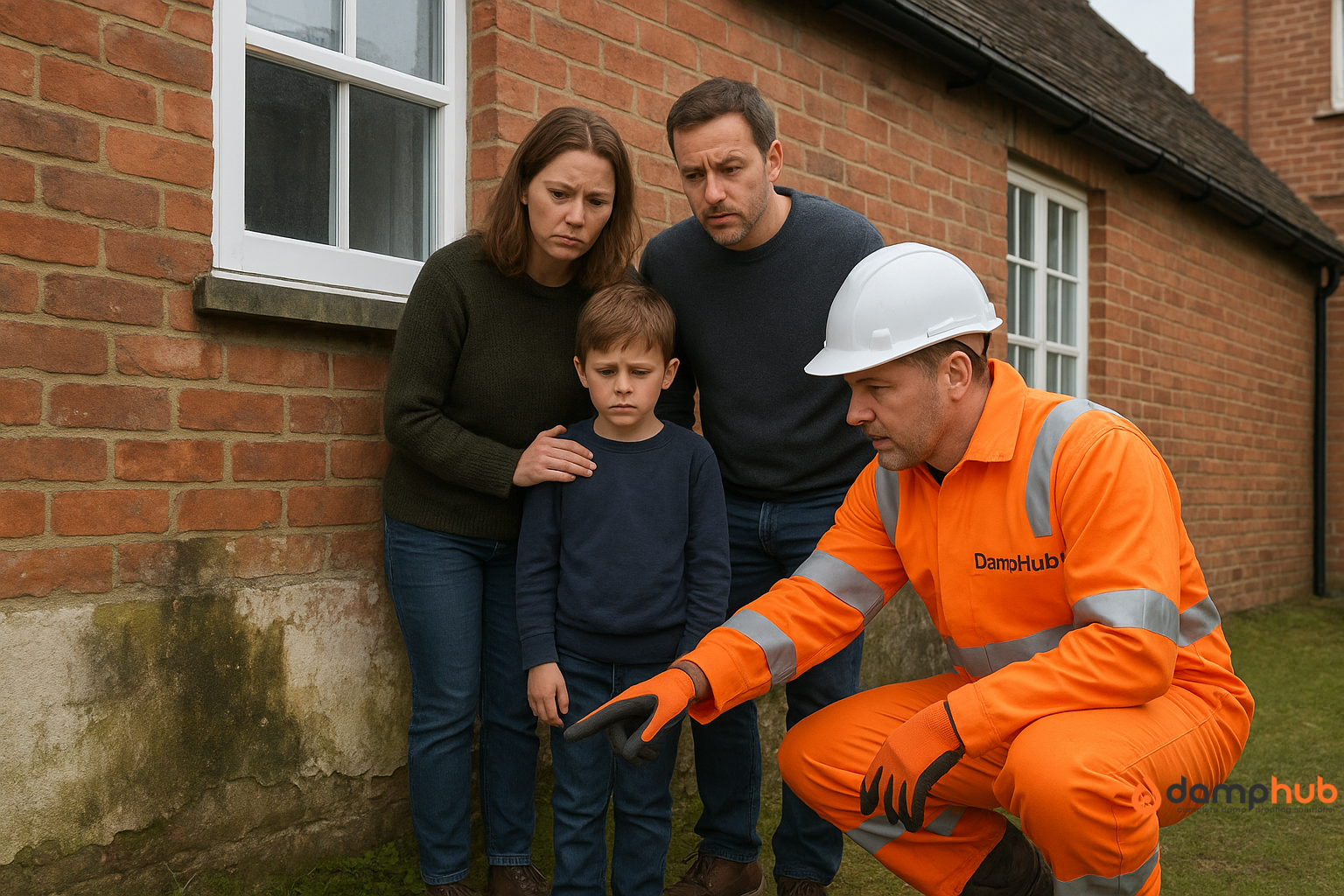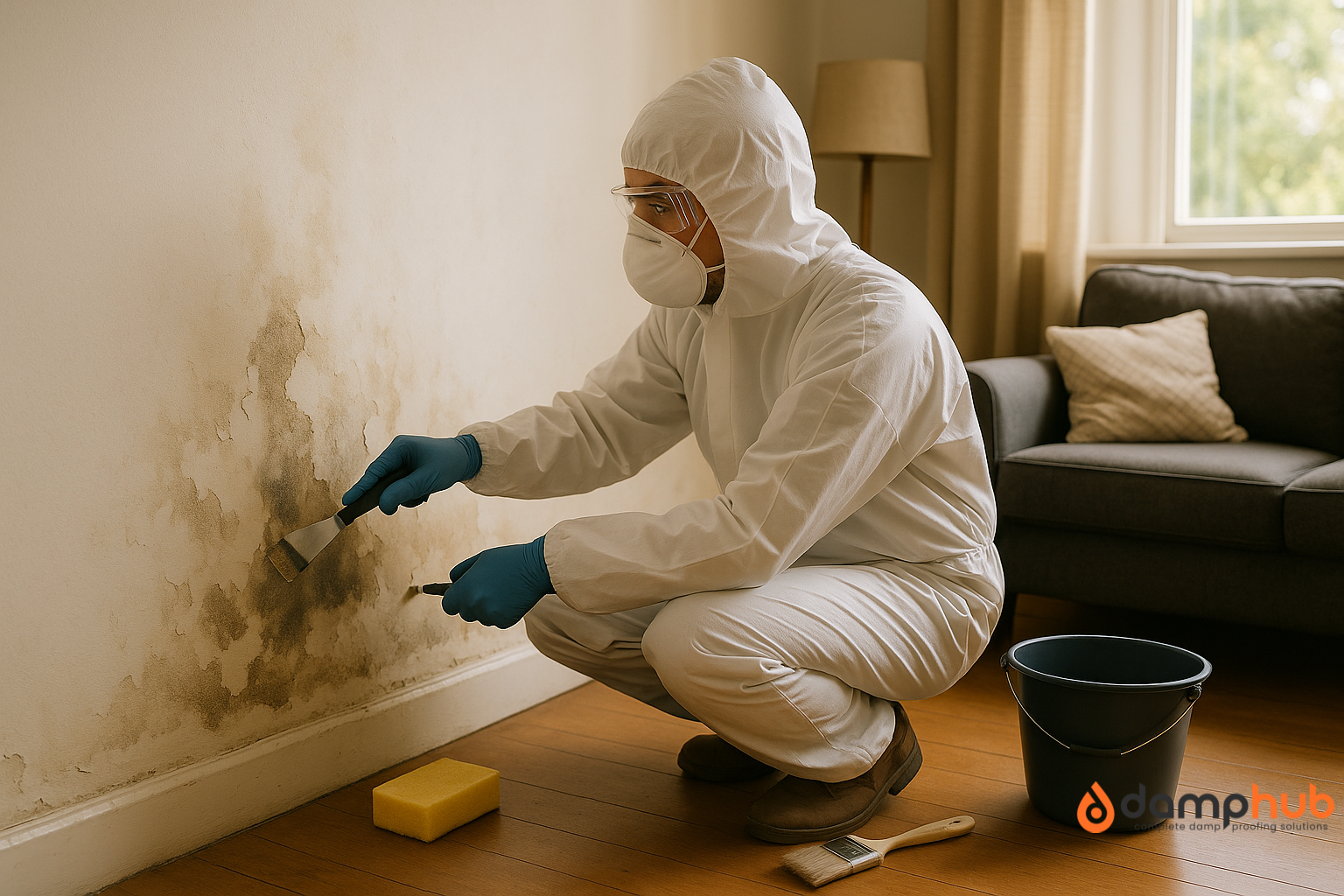
Damp proofing protects buildings from moisture damage, structural issues, and mould-related health risks.
In the UK, damp treatment costs range from £300 to over £5,000, depending on the type of damp, the extent of the damage, and the method used.
This guide breaks down damp proofing costs by treatment type, explains key price factors, and shows how to save money while protecting your home.
Forms of Damp and Their Treatment
Knowing the diverse forms of damp and the specific treatments they require before we move on to the cost is necessary:
Rising Damp: Caused by water from the ground that travels upwards through the walls.
Penetrating Damp: Due to water entering the building from walls, roofs, or windows.
Condensation: Caused by poor ventilation, it results in moisture building up on cold surfaces inside the property.
Each of these types of damp must be addressed uniquely, and prices will differ significantly depending on the treatment applied.

Damp Proofing Costs Overview
The cost of damp proofing in the UK also ranges from £300 to £5,000, depending on the severity of the issue and the treatment required.
Here’s a ballpark:
1. Rising Damp Treatment
Pricing: £400 – £15,000
Average per metre: £60 – £100 per linear metre of wall
Treatment: Involves installing a new damp-proof course (DPC), chemical injection, and possibly renewing plaster and skirting boards.
2. Penetrating Damp Treatment
Pricing: £400 – £2,500
Treatment: May involve repair of cracked walls, replacement of damaged bricks or roof tiles, sealing exterior walls, and improvement of drainage.
3. Condensation Control
Cost: £300 – £1,000+
Treatment: Includes fitting extractor fans, improving ventilation, use of dehumidifiers, and insulation.
4. Damp Survey
Cost: £150 – £400
Treatment: Professional surveying establishes the cause and extent of the problem before treatment.
👉 Related Blog: Damp Proofing How to Damp Proof a House: 7 Practical Tips from Industry Experts
Principal Determinants of Damp Proofing Expenses
The cost of damp proofing can vary greatly between properties, and it is based on several vital factors.
Knowing these factors can allow you to get ready for likely costs and make the correct decisions when purchasing damp treatment services.
1. Size of Affected Area
The size of the area that has been affected by damp is one of the most critical cost-establishing factors.
More work and materials are required for larger areas.
A single wet wall will require only a few metres of damp-proof injection, while a complete ground floor perimeter would entail large-scale treatment, including chemical injection, plaster stripping, and refurnishing.
Wall height and length are considerations.
Extremely wide or very high walls increase the job in terms of additional surface area.
Example: Treating a 5-metre wall can be anywhere from £500–£1,000, but treating an entire semi-detected house can be more than £5,000, depending upon the treatment method.
2. Type of Property
The style and age of build of your property play a key role in determining the level of complexity and cost of damp proofing.
Older buildings, especially those built before the 1950s, are unlikely to have modern damp-proof courses or insulation.
They may also use materials like lime mortar or solid walls, which require specialist techniques.
Listed or historic buildings will probably require approval from the local authority for alterations, and traditional materials may be required.
This requires time and finances.
Newer houses, while usually less troublesome to treat, can still be plagued by damp, particularly due to inferior building practice or poor ventilation.
In short, the older and more unique your house is, the higher the risk of damp treatment being complicated and expensive.
3. Extent of Damage
Damp is not just a matter of appearance — it can cause serious structural and cosmetic imperfections if left unaddressed.
The longer the damp, the greater the damage that has been done, and consequently, the larger the bill to repair.
Mild faults could be a matter of treating a wall and some redecorating.
Moderate to comprehensive damage could include:
- Rotten timber within joists or floors
- Plasterwork and paintwork that is damaged
- Skirting boards and flooring that have rotted
- Mould that will require professional removal
In severe situations, structural components will need to be strengthened or replaced, such as floorboards, beams, or even foundations.
Fixing the damp itself is frequently cheaper than the repair cost, so it is always a good idea to act early.
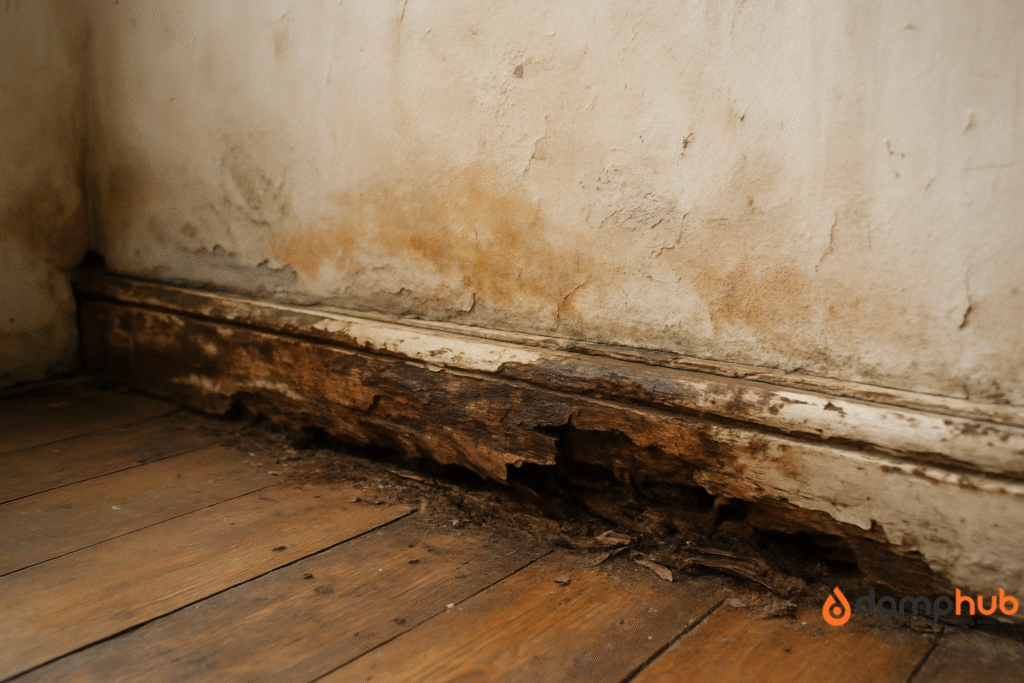
4. Access Issues
The degree to which contractors can reach the damp space will have a direct influence on labour time and cost.
Access difficulties are common:
- Damp behind fitted furniture, appliances, or radiators
- Loft, basement, or crawl space issues
- Damp below floorboards or inside cavity walls
Solutions may require:
- Moving heavy furniture
- Uplifting flooring
- Scaffolding for external wall work
- Breaking through walls or ceilings
All of these factors increase the time needed for the job, and that additional labour translates into higher costs.
👉 Related Blog: How to Remove Damp from Walls: The Ultimate Guide
5. Location of the Property
Your geographical location can significantly influence the total cost of damp proofing.
It is costlier in London and South East England due to the higher living standard being higher there.
You may get better bargains for similar services when you are in Northern and rural areas.
Proximity of specialists is also a factor.
Where damp proofing contractors are in high demand, you will find longer waiting periods and higher charges.
If your property is situated remotely or not readily accessible, travelling fees may be added to the total cost.
While making arrangements for damp proofing, make sure you factor in regional price variations while budgeting.
It would be sensible to get estimates from nearby and area contractors and compare them to ensure a reasonable deal.
Services and Prices of Damp Proofing
| Service | Typical Cost Range |
|---|---|
| Damp Survey | £150 – £400 |
| Chemical DPC Injection | £60 – £100 per metre |
| Internal Wall Plaster Removal | £20 – £40 per square metre |
| New Plastering & Decoration | £300 – £1,000+ |
| External Wall Sealing | £400 – £1,500 |
| Roof and Gutter Repairs | £150 – £1,000 |
| Ventilation Installation | £300 – £1,000+ |
Is Damp Proofing Worth it?
In most cases, yes — damp proofing is a cost that must be incurred.
Property Value: An internally dry property is easier to sell and maintains a higher value.
Health: Damp can lead to mould, a respiratory risk, especially to kids and asthma patients.
Structural Stability: Long-term damp will weaken masonry, wood, and other structures.
Not treating damp can lead to costly repairs in the future.

DIY vs. Professional Damp Proofing
Some minor condensation issues are addressable with a DIY solution, like operating dehumidifiers or improving airflow.
However, penetrating or rising damp requires professional treatment.
Treating or incorrectly diagnosing the problem will lead to recurring damp and higher expenses in the future.
👉 Read more from us: Damp Proofing UK – Costs, Rules, and What You Need to Know
Saving Money on Damp Proofing
1. Get Several Quotes
Always get quotes from no less than 3 experienced professionals and shop around by comparing quotations.
2. Book in Off-Peak Times
Off-peak seasons may offer cheaper rates with some builders.
3. Combine with Other Works
Labour is saved by combining damp proofing works with other jobs, e.g., re-plastering or redecoration.
4. Precautionary Actions
Guttering, roof tiles, and air vents will be inspected at regular intervals to avoid full-scale damp issues.
Questions to Ask Your Damp Specialist
Before you visit with a damp proof contractor, ask them the following:
- Are you PCA (Property Care Association) certified?
- Do you provide a written and comprehensive survey?
- What guarantee or warranty do you provide?
- Will the fee cover all the remedial work (plastering, repainting, etc.)?
A good company will not be evasive about the amount of work and the total cost.
👉 Also read: How to Treat Damp Walls Internally: A Step-by-Step Guide

Conclusion
Damp proofing can range from a few hundred to several thousand pounds, according to the issue.
The upfront cost may appear daunting, but the benefits — comfort and health, saving the property — outweigh it.
To avoid costly mistakes, start with a specialist survey and get on top of it early.
With proper maintenance and the right treatment, your home can go on being dry, healthy, and secure for years to come.
👉 Read more from us: Damp Proofing UK – Costs, Rules, and What You Need to Know
Common Questions Asked: How Much Does Damp Proofing Cost?
How much does damp devalue a house in the UK?
Damp can knock 5% to 20% off a property’s value, depending on severity and visibility. That’s up to £60,000 on a £300k home.
Surveyors flag it instantly, and buyers often walk away or renegotiate. It also limits mortgage options until resolved. Read our full guide How Much Can Damp Devalue Your Home?
How much compensation for damp and mould in the UK?
Compensation varies.
In private rentals, tenants can claim £750 to over £10,000, depending on health impact, duration, and whether the landlord ignored legal repairs.
Council or housing association tenants should follow the disrepair claim procedures. For more information, see our full guide How much Compensation is There for Damp and Mould in the UK
How much to damp proof a 3 bed house?
Typical cost ranges:
– Chemical DPC: £1,000–£2,500
– Membrane systems: £2,000–£5,000+
– Full re-plastering & finishing: Additional £1,000–£3,000
The final price depends on wall lengths, access, and underlying causes. Always get a full damp survey first.
What are the disadvantages of damp proofing?
– Misdiagnosis leads to wasted costs
– Overuse of chemicals in breathable walls can trap moisture
– Disruption: replastering, redecorating, access
– Not always effective if ventilation, gutters, or drainage aren’t fixed too
– Guarantees may be limited or void ifthe prep wasn’t right
Can damp come back after damp proofing?
Yes — if the wrong cause was treated, or the work was poorly done. Rising damp can reappear if bridging occurs (e.g., soil is too high).
Condensation can return without ventilation fixes. A damp report should always guide treatment.
Is damp proofing better than waterproofing?
Different jobs.
– Damp proofing resists slow moisture movement, like rising or penetrating damp.
– Waterproofing stops water under pressure, like from flooded basements.
For most UK homes, damp proofing is the standard. Waterproofing is used in basements or high-risk zones.
What is the best type of damp proofing?
It depends on the building.
– Modern homes: Plastic DPC or chemical injection
– Older properties: Breathable methods like lime render, improved drainage
– Basements: Membrane tanking systems
Best practice: match the method to the damp cause, not just apply a blanket fix.
What is the difference between damp block and damp proof?
– Damp block usually refers to paint or coating that repels surface moisture.
– Damp proof refers to more structural solutions, like barriers, membranes, or injected treatments to stop rising damp.
Damp block is short-term; damp proofing is long-term.

